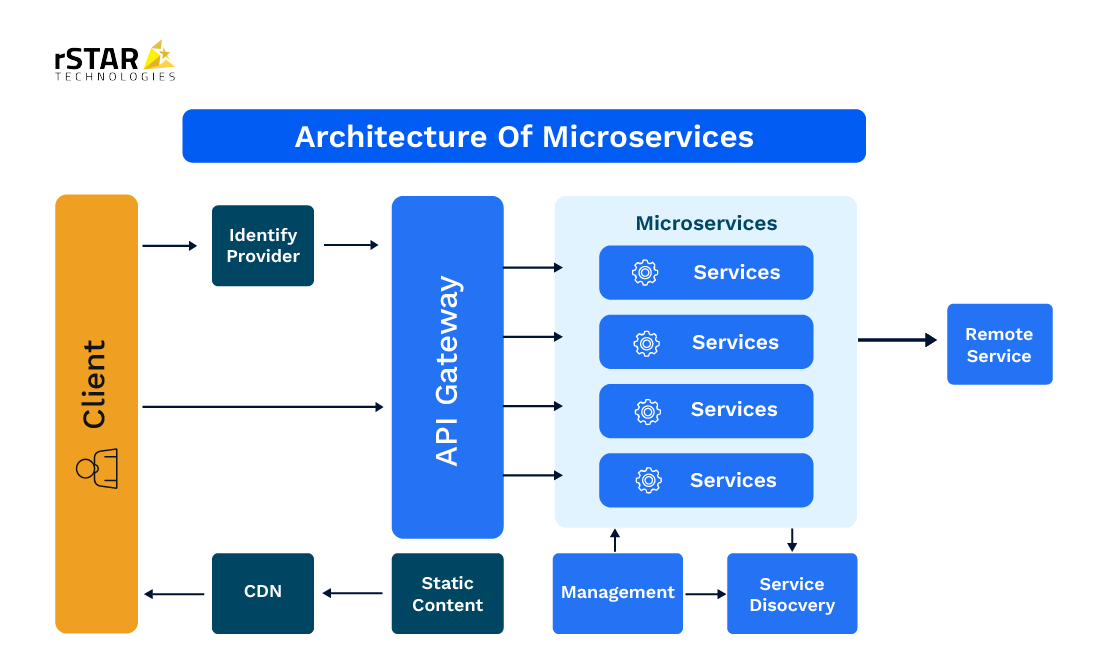Table of Contents
What Is a Microservices Architecture?
A microservices architecture is a modern software development method where complex applications are structured as smaller, independent units or services that stack together. Companies adopt this concept to integrate different business functions, enabling separate departments to work independently for the company’s collective success.
Microservices systems communicate with each other through application programming interfaces (APIs), enabling those systems to communicate during the deployment of business solutions.
These systems emanated from a history of software architecture patterns, including monolithic mainframe, client-server, web application, and service-oriented architecture. They have transformed operations from the days of monolithic systems.
Companies that are still operating monolithic systems are significantly limiting productivity and, of course, revenue. However, by extending these systems with a functional microservices architecture, these organizations experience numerous benefits.
Benefits of Extending Monolithic Legacy ERPs with a Microservices Architecture
Enhances Modularity and Agility
A microservices architecture enables companies to add modules to their ERP, each carrying out different functions. This is vital for developing, deploying, and maintaining solutions seamlessly.
Supports Independent System Scalability
One of the key benefits of extending monolithic legacy ERPs with a microservices architecture is that it empowers companies to scale different services independently based on their usage patterns and demand.
Scaling services independently allows for properly allocating business resources, enabling companies to optimize individual systems instead of wasting resources on the entire system. This optimization enhances business performance.
This is impossible with monolithic legacy systems, where everything is integrated into one application, from the hardware to the user interface, business logic, database, and utility programs. Any scalability plans for such systems would require breaking down the entire application to rebuild it.
Easier Maintenance and Updates
Independent system maintenance and updates is another essential benefit of a microservices architecture. Updating or maintaining a monolithic system is a complex and costly process that organizations dread experiencing.
Besides halting operations and revenue generation, it costs much more in maintenance fees as the entire system would need to be worked on instead of only the affected component.
This could also disrupt a system already functioning optimally, thus affecting productivity.
Companies can maintain and update individual services or units by adopting an effective microservices architecture without disrupting the entire system. This keeps other systems running while the maintenance and updates are ongoing, ensuring customers using those systems don’t experience downtime.
Enhances System Isolation and Repair
Since monolithic systems are integrated, a single bug or failure can bring down the entire system, causing a complete shutdown of business operations and leading to a bad customer experience.
This isn’t possible in a microservices system.
With a microservices architecture, a failure in one system or service is isolated from the rest, reducing its impact on the entire system.
Companies can repair failed and isolated systems while keeping other services active, ensuring customers aren’t left stranded due to issues that don’t directly affect them.
Promotes Team Autonomy
Microservices systems enhance team productivity on the micro levels and foster collaboration for the bigger picture. Teams can focus and work independently of each other on different parts of a bigger project.
During product development and deployment stages, teams can discuss and create sub-services that add to the end goal. They’re allowed to make independent decisions on design, development, and deployment, ensuring that whatever they’re building supports the actualization of the overall solution the company has in mind.
This benefit of microservices architecture enables organizations to design and deploy solutions faster.
Improves User Experience
Customer-centric businesses understand the long-term benefits of improved user experience and dread the severe drawbacks of a poor one. A single failure in a monolithic system leaves every customer stranded, even the ones not directly affected.
This isn’t the same when a microservices architecture is adapted. Customers can have seamless experiences at different service touchpoints, even when a specific service is down.
For instance, the failure of the mobile app will not affect the web app. This allows the customers to complete their transactions on the web app without hassle, minimizing the impact of the mobile app’s failure.
Furthermore, with the autonomy a microservices system grants teams, solutions can be built and deployed faster than with a monolithic system. This enhances the customer experience, increasing customer loyalty, lifetime value, and referrals.
Improves Overall Performance
Microservices systems improve the overall performance of a system or application, ensuring everything is in place to achieve business goals.
Organizations can optimize each section of their ERP system to function optimally, improving overall system performance.
For instance, different database systems can store the data from different enterprise units, enhancing data storage and retrieval, and preventing the negative effects of using one data storage system for the entire architecture.

Adopt Microservices Architecture System to Improve ROI
Transitioning from a monolithic legacy ERP system to a microservices architecture isn’t a walk in the park. It requires careful data planning, especially in breaking down your complex monolithic ERP functionalities into microservices, defining APIs for each microservice, and choosing an appropriate implementation strategy.
However, it must be done if the organization aims for limitless growth.
The benefits of adoption far outweigh the costs, often resulting in exponential ROI. An effectively adapted microservices system enhances the customer experience, streamlines operations, enhances productivity, drives revenue generation, and enhances organizational growth.




